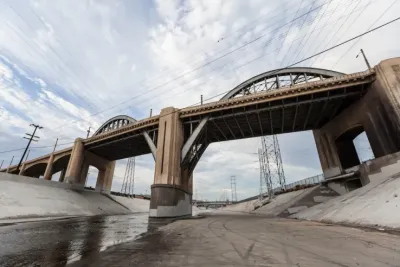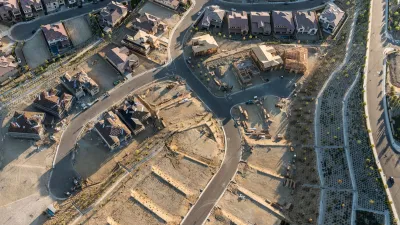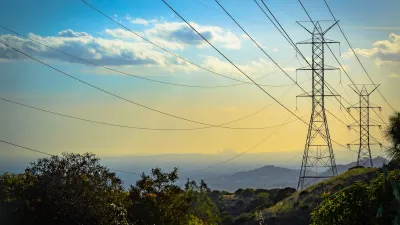A call for regenerative approaches to rebuilding that work with nature rather than against it.

As Los Angeles faces the devastating aftermath of a historic wildfire disaster, we Angelenos find ourselves grappling with how to rebuild. As the flames subside, the smoke clears, and atmospheric rivers rain down, an emerging narrative dominates the conversation: we must “harden” our landscape to prevent future fires. This response — a technical reaction to the immediate threat of fire — relies heavily on concrete, steel, and other impervious materials. But we have seen this engineering-based playbook before, and it has failed us.
In my previous role as the founding executive director of RiverLA, I saw firsthand the repercussions of this bias towards hardening our landscape. Following the catastrophic floods of the 1930s, Los Angeles poured concrete into the Los Angeles River, attempting to control the flow of water and prevent future disasters. The total amount of concrete is staggering: over 2 million cubic yards, enough to fill the infield of Dodger Stadium about 59 times. While this approach provided a short-term fix, the long-term consequences were far more complex. The hardened river channel sends 70 percent of LA's precious rainwater rushing downstream, lost to the ocean rather than being captured for local use. Less water percolates into the soil, creating drier conditions that are more vulnerable to fire. Community groups and local agencies have spent the last 30 years trying to undo the damage caused by over-engineering our waterways.
We cannot make the same mistake with our landscapes in the wake of fire. Hardening the city to prevent wildfire may seem like an obvious idea, but it comes at a cost, both to the environment and to our communities. For example, hardened landscapes intensify the urban heat island effect and dry the soil, perpetuating the cycle of disaster. A 2024 study led by the University of Massachusetts Amherst found nature-based solutions to be more cost-effective than conventional engineering solutions for reducing disaster risk, plus they contribute to the overall health of the ecosystem.
Nature is not a problem to be suppressed but a system to be understood and worked with.
But this requires a shift in how we view the landscape itself. One lesson I’ve learned from working at the intersection of finance, nature and culture is that we need to embrace the fragility of our environments — not as a problem, but as a benefit. We cannot simply fortify our land and expect that people will endure. It's this fragility that makes us human; it’s what connects us to one another, to our environment, and to the cycles of nature.
Rebuilding in the wake of disaster demands more than just restoring homes (and jobs and natural ecosystems); it requires us to rethink how we design our cities to withstand the challenges of the future. Yes, people are without homes, and our immediate priority must be to provide shelter. But we must also look beyond the immediate rebuilding effort and imagine a future that doesn’t just survive fire and flood but thrives in the face of them.
One path to this vision begins with community-driven, regenerative, nature-based approaches. As the executive director of the LA Community Garden Council, I know that the strength of our city lies not just in its infrastructure but in its people and their connection to the land. Community gardens, for example, are a powerful tool for resilience. They provide food security, foster social cohesion, and promote environmental stewardship while also capturing water, reducing the urban heat-island effect, and providing much-needed green spaces.
As an advisor to the Ubuntu Climate Initiative, I’ve come to recognize a deeper truth about the way we approach both climate and community resilience. Change is a cultural belief, specifically how we choose to adapt and evolve.
That is what resilience invites us to figure out: how can we change our thinking, rather than rely on an old habit of control and order? True power lies in our ability to innovate and imagine the world we want to live in, not resist the one we fear.
The African philosophy of Ubuntu reminds us that “I am because you are.” Our resilience, our power, is tied to the world around us, including the language we use to describe the change we seek. We do not need to harden our landscape, we need to heal our relationship to it.
We are at a crossroads. The path we choose today will shape the future of Los Angeles and beyond. It’s time for a new narrative: one where we rebuild not just for survival today, but for regeneration — for many generations to come.
Omar Brownson takes an entrepreneurial approach to tackling large-scale challenges at the intersection of land, community, and regenerative economies. He was the founding executive director of RiverLA, where he led efforts to reimagine the 51-mile Los Angeles River, securing $430 million for public access and green infrastructure. He currently serves as executive director of the Los Angeles Community Garden Council, supporting 40+ community gardens and over 2,000 members in fostering food sovereignty and shared governance. Omar also advises the Ubuntu Climate Initiative, co-hosts the Gratitude Blooming Podcast, and serves on the board of Commonweal.

Americans May Be Stuck — But Why?
Americans are moving a lot less than they once did, and that is a problem. While Yoni Applebaum, in his highly-publicized article Stuck, gets the reasons badly wrong, it's still important to ask: why are we moving so much less than before?

Using Old Oil and Gas Wells for Green Energy Storage
Penn State researchers have found that repurposing abandoned oil and gas wells for geothermal-assisted compressed-air energy storage can boost efficiency, reduce environmental risks, and support clean energy and job transitions.

Placekeeping: Setting a New Precedent for City Planners
How a preservation-based approach to redevelopment and urban design can prevent displacement and honor legacy communities.

Study: Maui’s Plan to Convert Vacation Rentals to Long-Term Housing Could Cause Nearly $1 Billion Economic Loss
The plan would reduce visitor accommodation by 25,% resulting in 1,900 jobs lost.

Idaho Data: Unexpected Vehicle Repairs Exacerbate Housing Instability, Eviction Risk
Over 21 percent of clients struggle with transportation barriers.

A Year-Long Investigation On Permanent Supportive Housing
The New York Times reveals what’s working and what’s not in the cornerstone of Housing First.
Urban Design for Planners 1: Software Tools
This six-course series explores essential urban design concepts using open source software and equips planners with the tools they need to participate fully in the urban design process.
Planning for Universal Design
Learn the tools for implementing Universal Design in planning regulations.
Heyer Gruel & Associates PA
City of Moreno Valley
Institute for Housing and Urban Development Studies (IHS)
City of Grandview
Harvard GSD Executive Education
Salt Lake City
NYU Wagner Graduate School of Public Service
City of Cambridge, Maryland





























